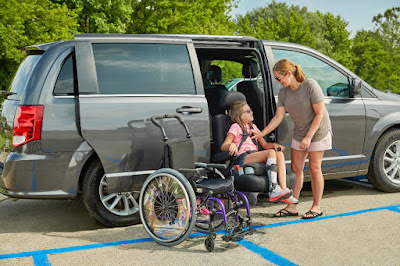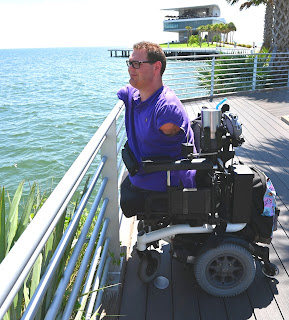 Once again, the holiday season is here! If your family is anything like mine, that means spending a lot of time with parents, siblings, aunts, uncles, cousins, and even friends. If you've ever wondered whether your place is accessible, fear not! Here are some tips to help you plan a holiday party that will be inviting to all of your guests, whether they use mobility equipment or not.
Once again, the holiday season is here! If your family is anything like mine, that means spending a lot of time with parents, siblings, aunts, uncles, cousins, and even friends. If you've ever wondered whether your place is accessible, fear not! Here are some tips to help you plan a holiday party that will be inviting to all of your guests, whether they use mobility equipment or not.
Outside
Since I'm a wheelchair user, I notice things that abled people typically take for granted. For example, some paths and walkways may seem like they're more accessible than they really are. Since they're pretty common, lets use pavers as an example. While they usually look beautiful, pavers and cobblestones can be difficult for wheelchair users to cross. Tires, and even some low-hanging parts, can actually get stuck in the cracks between each stone. The front casters of manual wheelchairs tend to catch on these gaps, making them both difficult and dangerous to traverse. Depending on how they're laid, pavers and cobblestones can also make for a pretty bumpy ride, making things more difficult for people who need extra support for their necks and backs.
Tires, and even some low-hanging parts, can actually get stuck in the cracks between each stone. The front casters of manual wheelchairs tend to catch on these gaps, making them both difficult and dangerous to traverse. Depending on how they're laid, pavers and cobblestones can also make for a pretty bumpy ride, making things more difficult for people who need extra support for their necks and backs.Gravel, sand, and soft dirt are a wheelchair user's kryptonite. You may not expect it, but most power and manual wheelchairs sink right into pockets of sand. Smooth, concrete sidewalks and walkways are definitely the most accessible for people who use wheelchairs, canes, walkers, scooters, or any other kind of mobility device. 32-inches is usually wide enough to accommodate these devices, and is also the ADA standard for public places like parks.
 Lawn parties can be a great way to spend time with your friends and family, but what if you're trying to put together a lawn party that's accessible to people who use mobility devices? While lush, green grass looks beautiful, it may be tough for manual wheelchair users to push themselves through. Unseen dips and holes could also make things tricky for people who are visually impaired or use power wheelchairs, walkers, canes, etc. In my heyday, I was known to flip a chair or two, so I've been on the receiving end of surprise lawn holes. Thick grass can also be tough on the motors of power wheelchairs, causing more wear and tear than usual. If you're worried that your yard may be too lush for it's own good, you can lay down some boards that lead from your house to the area where you'll be hanging out. If you're still concerned, it may be better to host your party indoors, or at least on a patio.
Lawn parties can be a great way to spend time with your friends and family, but what if you're trying to put together a lawn party that's accessible to people who use mobility devices? While lush, green grass looks beautiful, it may be tough for manual wheelchair users to push themselves through. Unseen dips and holes could also make things tricky for people who are visually impaired or use power wheelchairs, walkers, canes, etc. In my heyday, I was known to flip a chair or two, so I've been on the receiving end of surprise lawn holes. Thick grass can also be tough on the motors of power wheelchairs, causing more wear and tear than usual. If you're worried that your yard may be too lush for it's own good, you can lay down some boards that lead from your house to the area where you'll be hanging out. If you're still concerned, it may be better to host your party indoors, or at least on a patio.When it comes to the parking situation at holiday gatherings, make sure to leave enough room in between each one. 32 inches should be wide enough for wheelchair users to fit between. Accessible vehicles also need about 5-6 feet to safely load/unload a wheelchair or other type of mobility aid. Whether your guest has an accessible van, truck, SUV, or car, please extend a parking courtesy to those who may need it, and make sure that your other guests know.
Before you do anything, such as buying or building your own ramp, make sure to talk to the party host about your accessibility needs. You may discover that they already have a solution.
In the case that your host does not have an accessibility solution, preparing in advance could save you both a lot of time and frustration. You may need to either bring a ramp that you've purchased, or make your own.
As a word of caution, the Americans with Disabilities Act states that all public ramps should have an incline of no more than 5 degrees. To make sure that you stay safe during your holiday festivities, please keep this in mind. Under no circumstances should anybody remove the anti-tippers/wheelie bars from a wheelchair. If you think that your anti-tippers are preventing you from going up an incline, the angle is too steep. You may either need a longer ramp, or an entirely different solution.
Inside
Inside
According to the Americans With Disabilities Act, wheelchair accessible doorways are 32 inches wide, while hallways must be 36 inches wide. It may seem strange that accessible hallways are wider than doors, but wheelchair users need a little extra room to safely turn around. You may also arrange your furniture to follow these guideline.
Because of their size, certain rooms may be more or less accessible for people who use mobility devices. In particular, restrooms may be difficult for us to navigate. We can't assume that every home will have an accessible restroom, even if that home is owned by one of your family member or a close friends. While ADA standards may call for public facilities to install grab bars, to have raised toilet seats, or to have accessible controls for the sink, personal bathrooms aren't usually furnished this way. As a precaution, measuring the width of the bathroom door is always a great place to start. If you feel that the interior of your own bathroom is a bit cramped, it's OK to communicate that to your guests.
Because of their size, certain rooms may be more or less accessible for people who use mobility devices. In particular, restrooms may be difficult for us to navigate. We can't assume that every home will have an accessible restroom, even if that home is owned by one of your family member or a close friends. While ADA standards may call for public facilities to install grab bars, to have raised toilet seats, or to have accessible controls for the sink, personal bathrooms aren't usually furnished this way. As a precaution, measuring the width of the bathroom door is always a great place to start. If you feel that the interior of your own bathroom is a bit cramped, it's OK to communicate that to your guests.
After you've spent some time with your guests and have helped them feel comfortable, to get a better idea for future gatherings, you may want to ask them about the accessibility of your home. You can do this directly by asking questions like, "Do you need help?" or "How can I help you?" If you feel uncomfortable being so direct, consider asking more general questions, such as, "Are you enjoying yourself?" or "Can I get you anything?" The best approach will depend on you and your guests, so try and feel things out before asking.
Like any other party or gathering, the most important part is the food! By arranging entrees, sides, drinks, plates, silverware, etc., at an appropriate height, you'll give wheelchair users the opportunity to serve themselves; however, some of us still may need assistance. Usually, if we need help, we'll ask.
Though it might not seem ideal, in the case that you're house isn't accessible, it is always an option to host the event at a different location. That way, all of your guests feel included. Since the holidays are about enjoying each other's company, let's make this season a fun and accessible one!
Author:
Kyle Romano






No comments:
Post a Comment